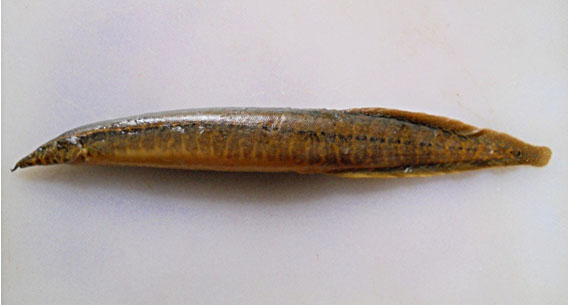|
Dorsal spines (total): 28-30; Dorsal soft rays (total): 60-72; Anal spines: 3-3; Anal soft rays: 65-67. This species is distinguished from its congeners by the following characters: D XXVIII-XXX; A 65-67; vertical lateral lines on the body 26-27; whitish yellow round spots 8-9, present in a row in between every two vertical lines and first dorsal spine originate at the level or a little behind the end of pectoral fin; comparatively greater body width (7.5-8.3 % SL), shorter dorsal (10.5- 13.0 % HL) and anal spines (13.2- 16.7 % HL), smaller eyes (3.7- 4.8 % HL), interorbital width 10.0-10.9 % HL, shorter width of gape of mouth (7.7- 9.7 % HL) and shorter lower jaw (9.1- 10.9 % HL); dorsal (2.2- 2.9 % SL), pectoral (28.6- 32.1) and anal fins (1.7- 2.6) are also
comparatively shorter in Macrognathus fasciatus (Ref. 95044). Further differs with relative species by the presence of pre-orbital spine; spinous part of dorsal fin originating at vertical through the level of or slightly behind the end of pectoral fin; head length 14.8-16.5 % SL; head depth 36.8-41.8 % HL; pre-dorsal length 22.2-26.1 % SL; height of dorsal fin 2.2-2.9 % SL; height of anal fin 1.7-2.6 %SL; pre-anal length 53.0-59.4 % SL. Colouration: body dark brown; presence of distinct vertical bands on the body (Ref. 97143). |
| The substrate of type locality of this species is generally sand or sandy gravel with occasional presence of bed rock or black clays. The area has a width of 45.0-125.0 m and a depth of 0.3- 8 m; bank height is 4.0- 5.0 m above the general water level in summer season. Moderate to dense riparian vegetation covers the area, with intermittent occurrence of low riparian vegetation noticed at certain places. Some of the major plants observed were Ochreinauclea missionis, Hydnocarpus pentandra, Aporosa lindleyana, Tribulus terretris, Tamarindus indica, Bombax ceiba. Associated fish species include Anguilla bengalensis, A. bicolor, Barilius bakeri, Dayella malabarica, Danio malabaricus, Puntius amphibius, Systomus subnasutus, Dawkinsia filamentosa, Haludaria fasciata, Pethia ticto, Mystus oculatus, Ompok malabaricus, Wallago attu,
Pseudotropius mitchelli, Batasio travancoria, Nandus nandus, Etroplus maculatus, Etroplus suratensis, Anabas testeudineus, Mastacembelus armatus, Channa striatus, C. marulius, C. gachua, C. micropeltes among others (Ref. 95044). |
